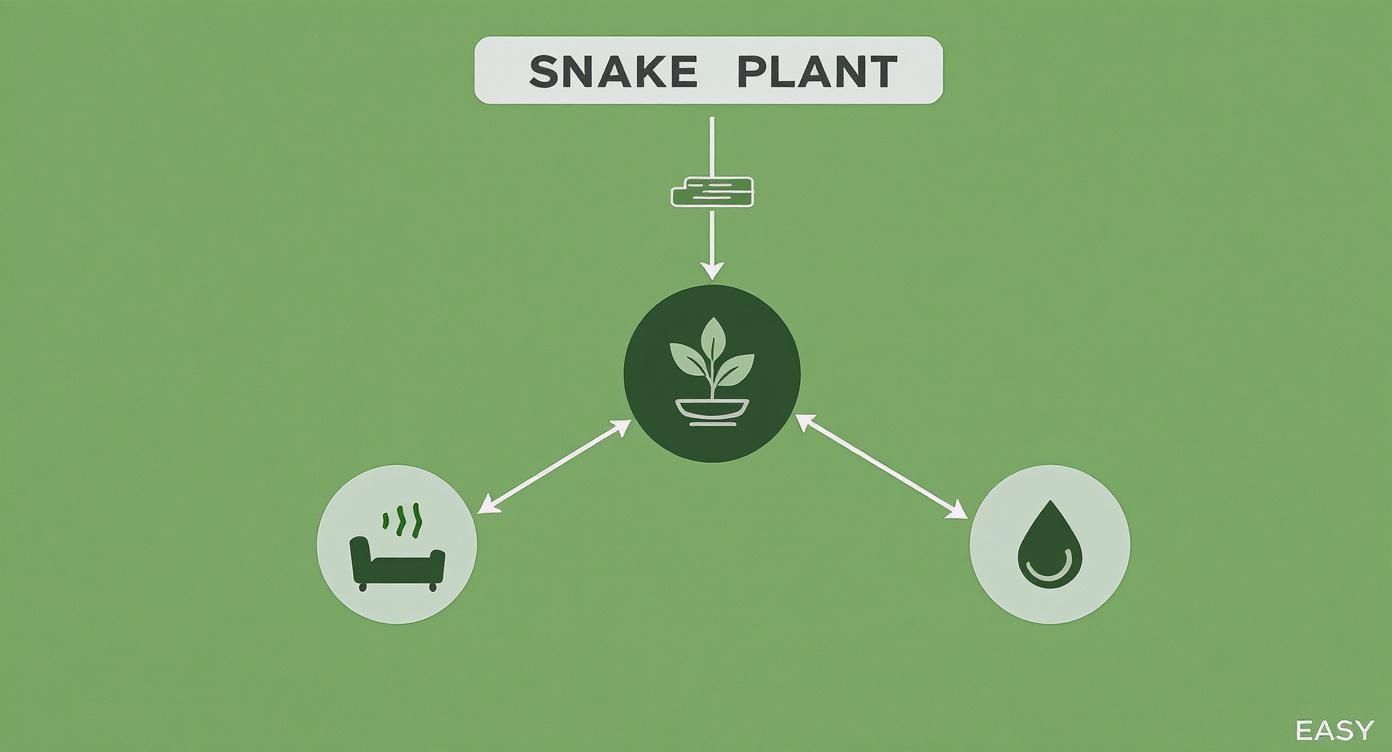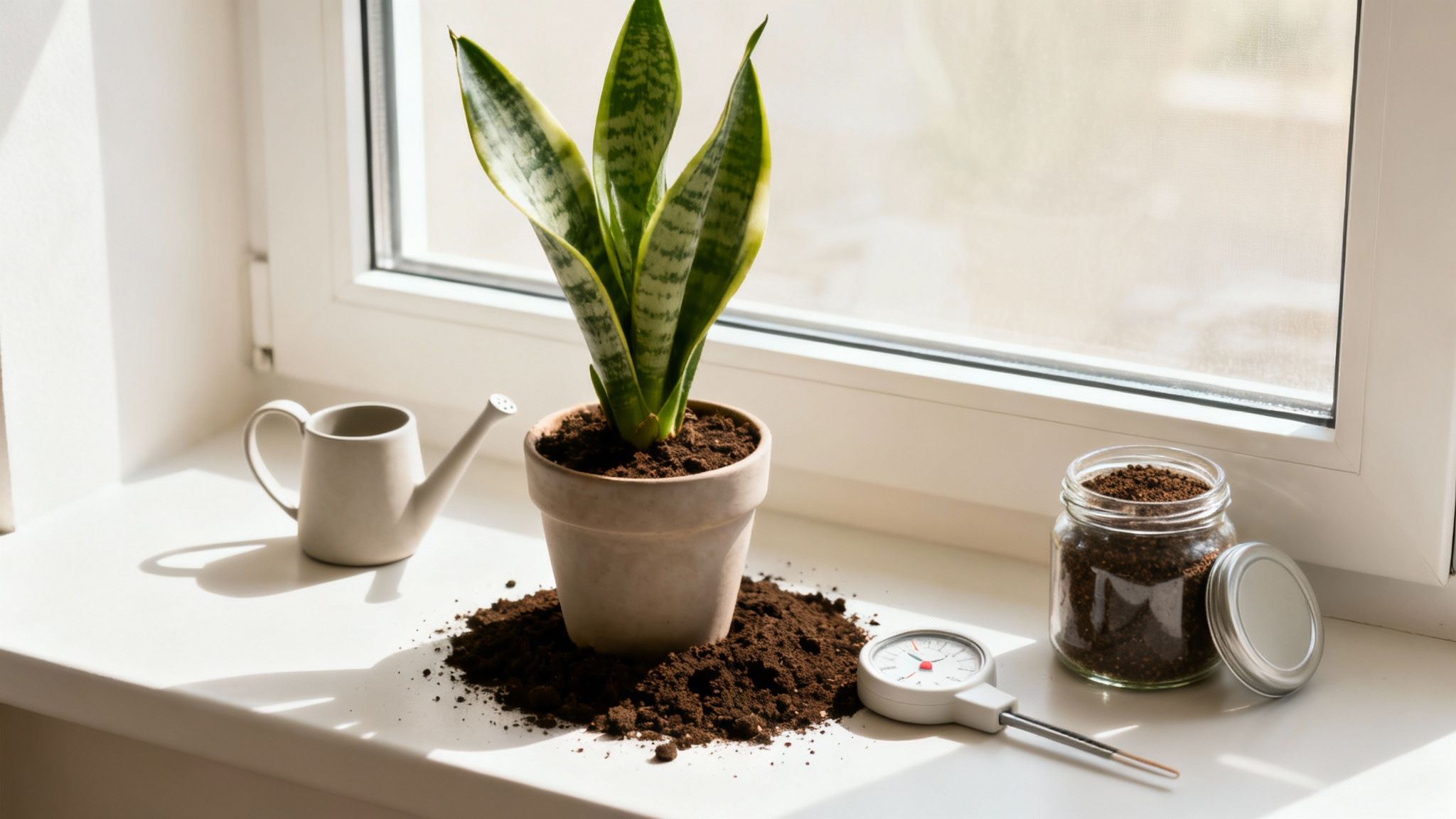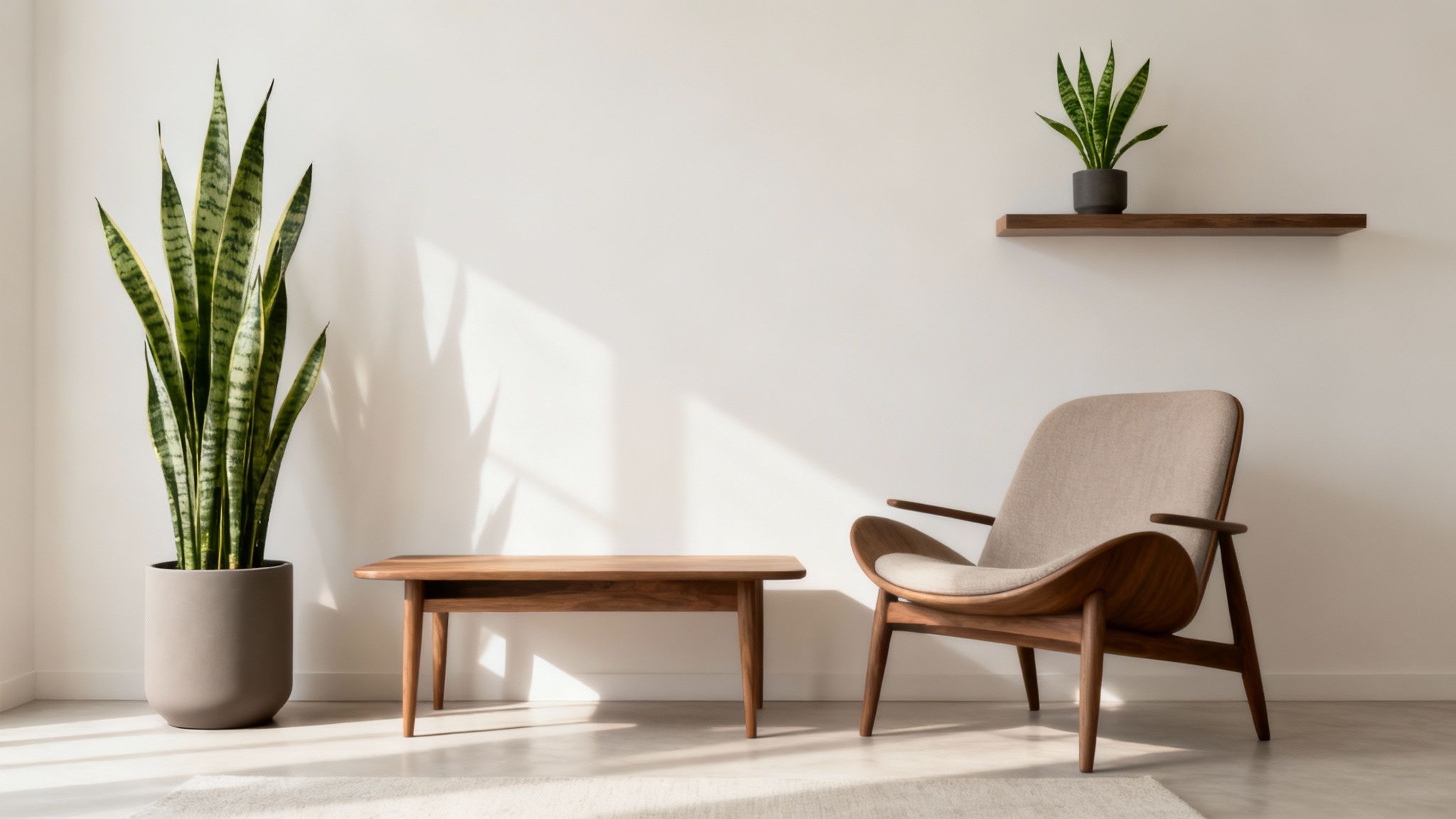The snake plant, known botanically as Dracaena trifasciata, is a highly regarded species in horticulture. It is a resilient, architectural houseplant that requires minimal maintenance while offering significant aesthetic and environmental benefits, making it a favorite for both novice plant owners and experienced collectors. With its striking, sword-shaped leaves and durable nature, it brings a touch of sophisticated greenery to any interior space.
The Enduring Appeal of the Snake Plant
The snake plant has transitioned from a common background plant to an icon of modern interior design. Its appeal lies in its dual identity as a living sculpture that is both visually striking and exceptionally hardy. This combination of form and function has secured its place as a staple for individuals aiming to cultivate a stylish, healthy, and vibrant home environment.
A key attribute contributing to the snake plant’s popularity is its remarkable resilience. It is known to tolerate conditions of low light and infrequent watering with ease, making it an ideal entry point for those new to houseplant care. For beginners, it is one of the easiest succulents to grow indoors and serves as an excellent confidence-booster.
A Statement of Effortless Style
The bold, upright leaves of the snake plant introduce a strong vertical element to a room, creating a sense of height and architectural drama. Its clean, minimalist aesthetic is versatile, complementing a wide range of decor styles, from the coastal elegance of a Hamptons residence to the modern lines of a New York City apartment.
Unlike more demanding plants that require constant attention, the snake plant provides sophisticated style with minimal upkeep. It is a low-effort, high-impact plant that elevates a room’s ambiance through its mere presence.
More Than Just a Decorative Plant
Beyond its aesthetic value, the snake plant is recognized for its air-purifying qualities. It is not merely a decorative object; it actively contributes to a healthier living environment by filtering common indoor pollutants. This functional benefit adds another layer to its appeal.
The snake plant demonstrates that great design can be both beautiful and beneficial. It proves that one does not need expert horticultural skills to create a space that feels stylish, vibrant, and restorative.
In the horticultural industry, snake plants are prized for their hardiness and unique air-purifying capabilities. Notably, unlike most plants, they perform crassulacean acid metabolism (CAM), allowing them to convert carbon dioxide into oxygen at night. This makes them particularly suitable for bedrooms, where they can improve air quality during sleeping hours. This unusual trait, combined with their tolerance for low light, has led to a surge in global demand, placing them among the top five most commercially sold indoor plants worldwide. Further details regarding snake plant benefits on Garden Luminous Tales are available for review.
Getting to Know the Snake Plant Family
While many people are familiar with the classic upright snake plant, the Dracaena genus is surprisingly diverse, encompassing dozens of varieties with distinct characteristics.
Familiarizing oneself with the different types allows for more nuanced interior styling. One can select a specific shape, color, and texture to perfectly complement a given space. Varieties range from tall and architectural to compact and nest-like, with foliage featuring silvery-green hues, dramatic dark stripes, or delicate golden edges.
Let’s explore some of the most popular varieties available.

Regardless of the chosen variety, the core benefits remain consistent: it is an air-purifying powerhouse, a natural style enhancer, and exceptionally easy to care for. This combination of features makes the snake plant a premier choice for creating a healthier, more beautiful home with minimal effort.
To assist in navigating the options, here is a brief overview of some of the most popular snake plant varieties, categorized by their key features and size.
A Quick Guide to Popular Snake Plant Varieties
| Variety Name | Key Characteristics | Average Height |
|---|---|---|
| ‘Laurentii’ | The classic variety. Features tall, sword-like leaves with bright yellow edges. | 2-4 feet |
| ‘Zeylanica’ | Similar in form to ‘Laurentii’ but lacks the yellow margins; features striking dark and light green patterns. | 2-3 feet |
| ‘Hahnii’ (Bird’s Nest) | A compact, dwarf variety that grows in a tight, nest-like rosette. | Under 6 inches |
| ‘Golden Hahnii’ | A Bird’s Nest type distinguished by its golden-yellow leaf margins. | Under 6 inches |
| Cylindrica | Features unique, spear-like cylindrical leaves that can be braided for stylistic effect. | 1-2 feet |
| ‘Moonshine’ | Known for its ethereal, pale silvery-green leaves. A highly sought-after variety. | 1-2 feet |
This table serves as a starting point. Part of the enjoyment of plant ownership is discovering new and interesting varieties. The following sections provide more detail on some of these types.
The Classic Upright Varieties
The upright varieties are the most recognizable and iconic. Their strong vertical lines introduce a sense of height and drama to any room.
- Dracaena trifasciata ‘Laurentii’: This is the quintessential snake plant. It is defined by its stiff, sword-like leaves—deep green centers with mottled grey-green stripes, framed by a vibrant creamy-yellow edge. The ‘Laurentii’ is a timeless classic, ideal for flanking a doorway or filling an empty corner.
- Dracaena trifasciata ‘Zeylanica’: The ‘Zeylanica’ can be considered a more understated version of the ‘Laurentii’. It shares the same stately form but without the yellow margins, resulting in a subtler, more sophisticated appearance. The leaves display an interwoven pattern of dark and light green bands, which is particularly effective in minimalist or modern interiors.
Compact and Charming Bird’s Nest Types
For smaller spaces, the Bird’s Nest varieties are an excellent solution. These plants form dense, charming rosettes that grow outwards rather than upwards, making them a perfect fit for bookshelves, desks, and side tables.
The most popular is Dracaena trifasciata ‘Hahnii’, a dwarf variety that typically remains under six inches tall. Its dark green leaves form an elegant cluster, making it an excellent companion for other small plants or succulents. For additional visual interest, the ‘Golden Hahnii’ offers the same compact shape with attractive golden-yellow variegation along the leaf edges.
Unique and Sculptural Forms
For those seeking to move beyond the classic flat-leafed varieties, some cultivars possess such unique forms they resemble living sculptures.
Dracaena angolensis (formerly Sansevieria cylindrica): Often called the African Spear Plant, this variety is highly distinctive. It has smooth, round, spear-like leaves that taper to a point. They are often sold braided but are equally stunning when allowed to grow naturally in a fan shape, creating a bold, modern statement.
Dracaena pearsonii: Nicknamed Rhino Horns, this variety has incredibly stiff, thick leaves that curve inward, resembling a horn. It is a stout, durable plant that adds an exotic element to a plant collection.
Ultimately, selecting the right snake plant involves matching its characteristics to your space. A tall ‘Laurentii’ can anchor a room, while a ‘Hahnii’ adds a perfect touch of green to a curated shelf. With an understanding of the available options, you can choose a plant that will not just survive, but will truly elevate your home’s style.
Mastering the Essentials of Snake Plant Care

Once you have selected the ideal snake plant, the care routine is remarkably straightforward. The art of snake plant care lies in understanding its minimal needs and avoiding over-attention.
These plants are native to the arid landscapes of West Africa and are thus adapted to withstand conditions that would be detrimental to most tropical houseplants. The objective is to provide an environment that subtly mimics their native habitat with appropriate light, water, and soil. Achieving this balance will ensure the plant not only survives but thrives.
Finding the Perfect Light
One of the primary advantages of the snake plant is its well-known tolerance for low light, making it a popular choice for dim corners or rooms with north-facing windows. However, it is important to distinguish between “surviving” and “thriving.”
A snake plant in low light will enter a state of near-dormancy. It will maintain its color and structure but exhibit minimal growth. To encourage new growth and help the plant reach its full potential, bright, indirect sunlight is required.
An understanding of “bright, indirect light” in a home setting is key:
- The Ideal Location: An east-facing window that receives gentle morning sun is optimal. Alternatively, a position a few feet from a south or west-facing window, where the light is bright but not direct enough to scorch the leaves, is also suitable.
- Signs of Proper Lighting: The colors of the foliage will be crisp and vibrant, especially on variegated varieties like ‘Laurentii’. New growth will be visible—slow and steady—during the spring and summer months.
- Signs of Insufficient Light: If the leaves become weak, the variegation fades, or the green turns dull and dark, it is a clear indication that the plant requires more light.
This adaptability is a significant factor in its commercial success. As consumers seek out air-purifying, sustainable greenery, the snake plant’s ability to flourish in various indoor environments has made it highly desirable. The global indoor plants market was valued at approximately USD 20.68 billion in 2024 and is projected to reach USD 30.25 billion by 2032, driven largely by demand for low-maintenance plants such as this. For further analysis, you can explore the trends in the indoor plant market on Mordor Intelligence.
The Golden Rule of Watering
The most common mistake in snake plant care is overwatering. These are succulent plants that store water in their leaves, making them highly susceptible to root rot if the soil remains consistently damp.
It is crucial to allow the soil to dry out completely between waterings. This is the cardinal rule for maintaining a healthy snake plant.
The most reliable method to check for moisture is to insert a finger about two inches into the soil. If any moisture is detected, refrain from watering. Depending on the light, temperature, and humidity of your home, this may result in a watering schedule of once every 2 to 8 weeks.
During the winter, the plant enters a dormant period and requires even less water. It is not uncommon to go a month or more between waterings. When in doubt, it is always safer to underwater.
Choosing the Right Soil Foundation
The correct soil mix is the best defense against overwatering. Snake plants require a potting medium that provides excellent drainage, allowing excess water to pass through quickly so the roots are never left in saturated conditions.
Standard all-purpose potting soil is typically too dense and retains excessive moisture. A gritty mix formulated for succulents and cacti is ideal. These blends contain ingredients like perlite, sand, or pumice to ensure proper aeration. You can purchase a pre-made mix or create your own. A reliable formula is:
- Two parts standard potting soil
- One part coarse sand or perlite
- One part peat moss or coco coir
This combination provides the optimal balance, giving the roots space to breathe while preventing the soil from becoming compacted and waterlogged.
A Minimalist’s Guide to Fertilizing
Snake plants are light feeders, and a conservative approach to fertilizing is recommended. Over-fertilizing can damage the roots and cause more harm than good.
Apply a balanced, all-purpose liquid houseplant fertilizer diluted to half-strength. An application in the spring as growth begins, and perhaps one more in mid-summer, is sufficient. Avoid fertilizing entirely in the fall and winter when the plant is dormant. This minimal feeding schedule is all that is required to maintain the plant’s health and appearance for years.
Troubleshooting Common Snake-Plant Problems
Even the most resilient plants can exhibit signs of stress. While snake plants are famously durable, they will indicate when their environmental conditions are not ideal. Fortunately, the signs are typically easy to interpret and rectify. The plant’s leaves serve as a visual indicator of its health, reflecting the conditions beneath the soil.
The vast majority of issues encountered with a snake plant can be attributed to a single cause: excessive watering. Their succulent nature makes them adapted to dry conditions and highly sensitive to oversaturation. Below are the most common signs of trouble and how to resolve them.
Decoding Yellow Leaves
Yellowing leaves are the primary signal of a stressed snake plant. Most often, this indicates excessive moisture in the soil.
When soil remains waterlogged, the roots are deprived of oxygen and begin to decay, a condition known as root rot. This decay progresses up the plant, manifesting as yellow, soft leaves that may begin to droop. In rarer instances, yellowing can also be a sign that the plant is severely root-bound or reacting to a sudden cold draft.
If you observe yellowing leaves, follow this action plan:
- Cease Watering Immediately: Do not water the plant again until the problem has been diagnosed.
- Inspect the Roots: Gently remove the plant from its pot. Healthy roots should be firm and off-white. Dark, mushy, or foul-smelling roots are indicative of rot.
- Prune and Repot: Using sterile scissors, trim away all rotted roots. Repot the plant in a new container with excellent drainage and a fresh, fast-draining succulent soil mix.
- Adjust Your Schedule: After repotting, allow the plant at least a week to acclimate before watering. Moving forward, only water when the soil is 100% dry from top to bottom.
A useful analogy is to consider the snake plant’s soil as a sponge. It must be completely dry before it is ready to absorb more water. Maintaining constant dampness is a formula for failure.
Addressing a Mushy Base and Root Rot
A soft, mushy base is the most severe symptom of overwatering and a definitive sign of advanced root rot. If the base of the leaves feels squishy to the touch, immediate action is required to save the plant. This occurs when fungi, which thrive in waterlogged soil, attack and destroy the plant’s root system.
Discovering a mushy base necessitates a rescue operation. The goal is to salvage any healthy tissue before the rot spreads further.
This requires minor plant surgery. Carefully remove the plant from its pot and rinse the old soil from the roots for a clear view of the damage. Trim away all black, soft, or foul-smelling tissue. If only healthy leaves remain, they can be propagated to grow a new plant. If a portion of the rhizome (the horizontal root structure) is still firm and healthy, that section can be repotted in fresh, sterile soil.
Solving Brown, Crispy Leaf Tips
While overwatering is the most common problem, brown and crispy leaf tips typically indicate the opposite issue: underwatering or inconsistent watering. This can occur when a plant is left completely dry for an extended period, causing the cells at the leaf tips to die.
Another potential cause is water quality. Tap water in many regions contains high levels of salts and minerals, which can accumulate in the soil over time and lead to “tip burn.”
- Review Your Routine: While the soil should dry out completely, do not leave it desiccated for weeks at a time. Consistency is important.
- Assess Your Water: If you have hard water, consider using filtered, distilled, or rainwater.
- Aesthetic Correction: For purely cosmetic purposes, the brown tips can be trimmed off with clean scissors. Following the natural V-shape of the leaf will make the cut less noticeable.
How to Propagate Your Snake Plant
One of the most rewarding aspects of owning a snake plant is the ease with which it can be propagated. Propagation allows you to expand your collection, create a fuller-looking pot, or share the plant with others. It is an excellent way to engage with your plant beyond basic care.
There are two effective and straightforward methods for propagating snake plants. Both are simple and require only basic tools, making them suitable projects for any plant enthusiast.
Propagating with Leaf Cuttings
This method is ideal for creating multiple new plants from a single healthy leaf. It requires patience, but observing a small leaf section develop new roots and pups is a fascinating process.
Here is the step-by-step procedure:
- Select a Healthy Leaf: Choose a mature, robust leaf that is free from blemishes or damage. Using a sharp, sterile knife or scissors, cut it off near the base of the plant.
- Cut into Sections: Place the leaf on a flat surface and slice it horizontally into several 2- to 3-inch segments. It is helpful to cut a small V-shape at the bottom of each piece to identify the correct orientation for planting.
- Allow to Callus: This is a critical step for success. Let the cuttings sit in a dry, bright location for several days to allow the cut ends to dry and form a callus. This process prevents the cuttings from rotting during the rooting phase.
The callusing process creates a protective seal over the open wound, safeguarding it from bacteria and decay, which is essential for successful rooting.
Once the cuttings have callused, there are two options for rooting. You can place the bottom ends in a jar with about an inch of water (changing it weekly), or you can plant them directly into a pot filled with a damp, well-draining succulent mix. The appearance of roots can take anywhere from a few weeks to a couple of months, so patience is key.
Dividing at the Rhizome
If your snake plant has produced smaller offshoots, known as pups, division is the fastest method for creating a new, independent plant. The best time for this procedure is during the spring or summer, particularly if you are already planning to repot.
This process centers on the rhizome, which is the thick, fleshy stem that runs horizontally underground and connects the various leaf clusters.
To divide the plant, remove it from its pot and gently brush away the excess soil to expose the root system. You will be able to see where the pups are connected to the main plant by the rhizome. Using a clean knife, make a clean cut to separate a pup, ensuring it has at least a few leaves and its own set of roots.
Pot this new division in its own container with fresh soil. Water it lightly, and thereafter care for it as you would a mature plant. This method offers immediate results, yielding a new snake plant instantly.
For more in-depth information, you can explore these detailed propagation techniques for snake plants to further expand your collection.
How to Style Snake Plants in Your Home

A snake plant is more than just a houseplant; it is a piece of living sculpture. Its strong, architectural lines and striking patterns provide an opportunity to introduce a natural yet modern element into your home. The key is to treat it as a deliberate design choice rather than an afterthought. A well-placed snake plant can anchor a room, create a stunning focal point, or add subtle texture.
To fully leverage the snake plant as a design statement, one must appreciate its form. The upright, sword-like leaves create a powerful vertical line, making them an excellent tool for adding height and drama to a space. By working with this natural shape, you can elevate your interior decor from merely pleasant to truly sophisticated.
Creating Vertical Interest and Focal Points
Tall snake plant varieties, such as the classic ‘Laurentii’ or ‘Zeylanica’, excel at creating verticality. Their height naturally draws the eye upward, which can make ceilings feel higher and a room seem more expansive. This makes them ideal for strategic placement where a significant impact is desired.
Consider placing taller plants in these locations:
- Corner Accents: An empty corner can often feel neglected. Placing a tall snake plant there fills the void with life and structure, transforming an underutilized area into a deliberate design moment.
- Flanking Furniture: To create a sense of symmetry and formal elegance, position a pair of matching snake plants on either side of a console table, fireplace, or sofa. This technique frames the furniture, creating a beautifully curated vignette.
- Entryway Statements: First impressions are important. A large snake plant in a decorative planter near the front door establishes a stylish and welcoming tone for the entire home.
It is not surprising that these resilient plants are increasingly utilized in settings ranging from private homes to corporate wellness programs designed to enhance employee well-being. This reflects a larger trend, with the indoor plant market experiencing significant growth due to urbanization and shifting lifestyle priorities. In North America, in particular, there is a growing awareness of the mental and physical benefits of indoor greenery. You can learn more about the growth of the indoor plant market on Custom Market Insights.
Styling with Compact Varieties
Not every space requires a tall plant. Smaller, more compact snake plant varieties like the ‘Hahnii’ (Bird’s Nest) or the ‘Golden Hahnii’ offer different styling opportunities. Their charming, rosette-like shape provides texture and a touch of green without overwhelming a smaller area.
Compact snake plants serve as an excellent finishing touch—the living object that enlivens a shelf, desk, or tabletop with organic form and color.
These petite varieties are effective when grouped in curated collections. Place a ‘Bird’s Nest’ snake plant on a bookshelf alongside books and art objects, or use one to bring life to a home office desk. Their small footprint allows them to fit almost anywhere, adding a welcome splash of nature to unexpected corners.
Choosing the Perfect Planter
The choice of planter is as important as the plant itself. It serves as the frame for your living artwork and should complement both the plant and your existing decor. The right pot is what seamlessly integrates the snake plant into the room’s overall aesthetic.
Here are a few suggestions for pairing planters with your style:
- Modern Minimalist: Opt for clean lines and a neutral palette. A simple ceramic cylinder in white, black, or grey allows the plant’s graphic leaves to remain the primary focus.
- Rustic Chic: To add warmth, focus on texture. Terracotta, woven baskets, or raw concrete planters contribute an earthy, organic feel.
- Hamptons Coastal: To capture a light, airy, and sophisticated beachside aesthetic, choose planters in crisp white, soft blue, or natural woven materials like rattan or seagrass.
Ultimately, styling a snake plant is about recognizing its aesthetic potential. Whether standing tall in a corner or nestled on a shelf, its unique form offers endless possibilities to enhance your home with effortless, living style.
Your Snake Plant Questions, Answered
Even the most straightforward plants can raise a few questions. Whether you are a new or experienced snake plant owner, it is helpful to have quick answers to common queries.
This section serves as a reference for frequently asked questions, from pet safety to the rare occurrence of blooms.
Are Snake Plants Toxic to Pets?
This is a primary concern for pet owners. The answer is yes, snake plants are mildly toxic to cats and dogs if ingested.
The leaves contain natural compounds called saponins, which can cause gastrointestinal upset. If a pet chews on a leaf, symptoms may include drooling, vomiting, or diarrhea. While rarely serious, it can cause discomfort. To ensure safety, it is advisable to place the snake plant out of reach of pets.
How Fast Do Snake Plants Grow?
Snake plants are known for their slow and steady growth rate. This is considered part of their appeal, as they do not require frequent repotting.
The rate of growth is directly influenced by their environment:
- With ample bright, indirect light, a plant may produce three or four new leaves during the spring and summer.
- In a low-light setting, growth will slow significantly. The plant might produce only one or two new leaves per year, or sometimes none at all.
This deliberate growth makes them highly predictable and ideal for interior styling, as they maintain their shape and size for long periods.
A slow-growing snake plant is not an indication of poor health; it is simply the plant’s nature. Patience is part of the ownership experience, and its steadfast presence is the true reward.
Do Snake Plants Flower?
Although infrequent, snake plants can produce flowers. When this occurs, it is a notable event. A tall stalk emerges, covered in clusters of small, greenish-white, fragrant flowers. The scent is typically most potent at night.
Flowering is often a sign that the plant is under mild stress, usually from being root-bound in its pot. While it is a beautiful sight, it is not an annual occurrence. If your snake plant blooms, simply enjoy the rare and delicate display.
For more insights into creating a beautifully curated and stylish life, explore Social Life Magazine. Discover exclusive features on art, design, and sophisticated living that inspire elegance in every corner of your home. Find your inspiration at https://www.sociallifemagazine.com.






